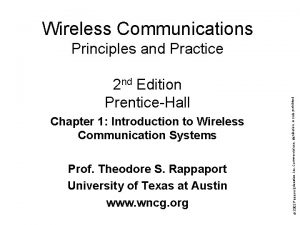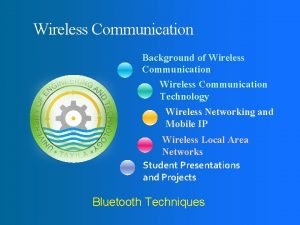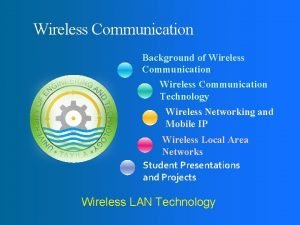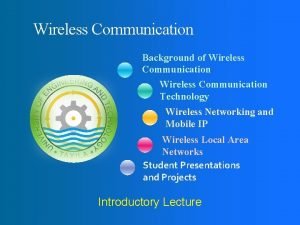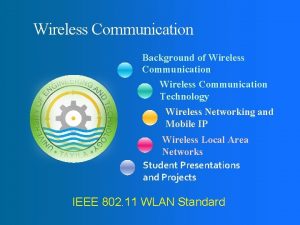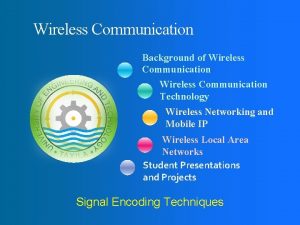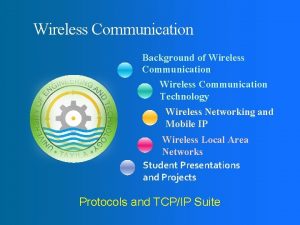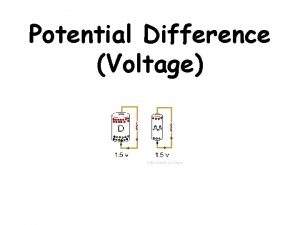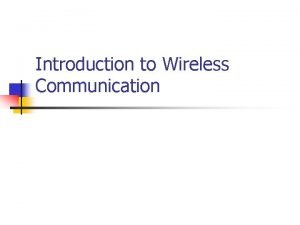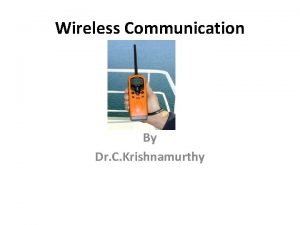WIRELESS COMMUNICATION INTRODUCTION NEED FOR WIRELESS COMMUNICATION DIFFERENCE













- Slides: 13

WIRELESS COMMUNICATION � INTRODUCTION � NEED FOR WIRELESS COMMUNICATION � DIFFERENCE BETWEEN WIRELESS AND CORDLESS COMMUNICATON � EARLIER DEVELOPMENTS � GENERATIONS OF THE WIRELESS COMMUNICATION v FIRST GENERATION(1 G) v SECOND GENERATION(2 G) o 2 G TECHNOLOGIES v THIRD GENERATION(3 G) o 3 G TECHNOLOGIES o FUTURE GENERATION(4 G) q APPLICATIONS AND FUTURE ASPECTS

Wireless communication is the transfer of information over a distance without the use of enhanced electrical conductors or "wires". The distances involved may be short (a few meters as in television remote control) or long (thousands or millions of kilometers for radio communications). When the context is clear, the term is often shortened to "wireless". Wireless communication is generally considered to be a branch of telecommunications. It encompasses various types of fixed, mobile, and portable two-way radios, cellular telephones, personal digital assistants (PDAs), and wireless networking. Other examples of wireless technology include GPS units, garage door openers and or garage doors, wireless computer mice, keyboards and headsets, satellite television and cordless telephones.

Wireless networking (i. e. the various types of unlicensed 2. 4 GHz Wi-Fi devices) is used to meet many needs. Perhaps the most common use is to connect laptop users who travel from location to location. Another common use is for mobile networks that connect via satellite. A wireless transmission method is a logical choice to network a LAN segment that must frequently change locations. The following situations justify the use of wireless technology: To span a distance beyond the capabilities of typical cabling, To provide a backup communications link in case of normal network failure, To link portable or temporary workstations, To overcome situations where normal cabling is difficult or financially impractical, or To remotely connect mobile users or networks.

The term "wireless" should not be confused with the term "cordless", which is generally used to refer to powered electrical or electronic devices that are able to operate from a portable power source (e. g. a battery pack) without any cable or cord to limit the mobility of the cordless device through a connection to the mains power supply. Some cordless devices, such as cordless telephones, are also wireless in the sense that information is transferred from the cordless telephone to the telephone's base unit via some type of wireless communications link. This has caused some disparity in the usage of the term "cordless", for example in Digital Enhanced Cordless Telecommunications. In the last fifty years, wireless communications industry experienced drastic changes driven by many technology innovations.

The term "wireless" came into public use to refer to a radio receiver or transceiver (a dual purpose receiver and transmitter device), establishing its usage in the field of wireless telegraphy early on; now the term is used to describe modern wireless connections such as in cellular networks and wireless broadband Internet. It is also used in a general sense to refer to any type of operation that is implemented without the use of wires, such as "wireless remote control" or "wireless energy transfer", regardless of the specific technology (e. g. radio, infrared, ultrasonic) that is used to accomplish the operation. While Guglielmo Marconi and Karl Ferdinand Braun were awarded the 1909 Nobel Prize for Physics for their contribution to wireless telegraphy. In 1885, T. A. Edison used a vibrator magnet for induction transmission. In 1888, Edison deployed a system of signaling on the Lehigh Valley Railroad. In 1891, Edison obtained the wireless patent for this method using inductance (U. S. Patent 465, 971). In the history of wireless technology, the demonstration of theory of electromagnetic waves by Heinrich Hertz in 1888 was important. The theory of electromagnetic waves was predicted from the research of James Clerk Maxwell and Michael Faraday. Hertz demonstrated that electromagnetic waves could be transmitted and caused to travel through space at straight lines and that they were able to be received by an experimental apparatus. The experiments were not followed up by Hertz. Jagadish Chandra Bose around this time developed an early wireless detection device and help increase the knowledge of millimeter length electromagnetic waves. Practical applications of wireless radio communication and radio remote control technology were implemented by later inventors, such as Nikola Tesla.

1 G (or 1 -G) refers to the first-generation of wireless telephone technology, mobile telecommunications. These are the analog telecommunications standards that were introduced in the 1980 s and continued until being replaced by 2 G digital telecommunications. The main difference between two succeeding mobile telephone systems, 1 G and 2 G, is that the radio signals that 1 G networks use are analog, while 2 G networks are digital. Although both systems use digital signaling to connect the radio towers (which listen to the handsets) to the rest of the telephone system, the voice itself during a call is encoded to digital signals in 2 G whereas 1 G is only modulated to higher frequency, typically 150 MHz and up. One such standard is NMT (Nordic Mobile Telephone), used in Nordic countries, Switzerland, Netherlands, Eastern Europe and Russia. Others include AMPS (Advanced Mobile Phone System) used in the United States and Australia, TACS (Total Access Communications System) in the United Kingdom, C-450 in West Germany, Portugal and South Africa, Radiocom 2000 in France, and RTMI in Italy. In Japan there were multiple systems. Three standards, TZ-801, TZ-802, and TZ-803 were developed by NTT, while a competing system operated by DDI used the JTACS (Japan Total Access Communications System) standard. Antecedent to 1 G technology is the mobile radio telephone, or 0 G

2 G (or 2 -G) is short for second-generation wireless telephone technology. Second generation 2 G cellular telecom networks were commercially launched on the GSM standard in Finland by Radio linja (now part of Elisa Oyj) in 1991. Three primary benefits of 2 G networks over their predecessors were that phone conversations were digitally encrypted, 2 G systems were significantly more efficient on the spectrum allowing for far greater mobile phone penetration levels; and 2 G introduced data services for mobile, starting with SMS text messages. After 2 G was launched, the previous mobile telephone systems were retrospectively dubbed 1 G. While radio signals on 1 G networks are analog, and on 2 G networks are digital, both systems use digital signaling to connect the radio towers (which listen to the handsets) to the rest of the telephone system.

2 G technologies can be divided into TDMA-based and CDMA-based standards depending on the type of multiplexing used. The main 2 G standards are: GSM (TDMA-based), originally from Europe but used in almost all countries on all six inhabited continents (Time Division Multiple Access). Today accounts for over 80% of all subscribers around the world. Over 60 GSM operators are also using CDMA 2000 in the 450 MHz frequency band (CDMA 450). IS-95 aka cdma. One (CDMA-based, commonly referred as simply CDMA in the US), used in the Americas and parts of Asia. Today accounts for about 17% of all subscribers globally. Over a dozen CDMA operators have migrated to GSM including operators in Mexico, India, Australia and South Korea. PDC (TDMA-based), used exclusively in Japan i. DEN (TDMA-based), proprietary network used by Nextel in the United States and Telus Mobility in Canada IS-136 aka D-AMPS (TDMA-based, commonly referred as simply 'TDMA' in the US), was once prevalent in the Americas but most have migrated to GSM. 2 G services are frequently referred as Personal Communications Service, or PCS, in the United States. 2. 5 G services enable high-speed data transfer over upgraded existing 2 G networks. Beyond 2 G, there's 3 G, with higher data speeds, and even evolutions beyond 3 G, such as 4 G.

International Mobile Telecommunications-2000 (IMT--2000), better known as 3 G or 3 rd Generation, is a generation of standards for mobile phones and mobile telecommunications services fulfilling specifications by the International Telecommunication Union. Application services include widearea wireless voice telephone, mobile Internet access, video calls and mobile TV, all in a mobile environment. Compared to the older 2 G and 2. 5 G standards, a 3 G system must allow simultaneous use of speech and data services, and provide peak data rates of at least 200 kbit/s according to the IMT-2000 specification. Recent 3 G releases, often denoted 3. 5 G and 3. 75 G, also provide mobile broadband access of several Mbit/s to laptop computers and smartphones.

The following standards are typically branded 3 G: the UMTS system, first offered in 2001, standardized by 3 GPP, used primarily in Europe, Japan, China (however with a different radio interface) and other regions predominated by GSM 2 G system infrastructure. The cell phones are typically UMTS and GSM hybrids. The original and most widespread radio interface is called W-CDMA. The latest release, HSPA+, can provide peak data rates up to 56 Mbit/s in the downlink in theory (28 Mbit/s in existing services) and 22 Mbit/s in the uplink. the CDMA 2000 system, first offered in 2002, standardized by 3 GPP 2, used especially in North America and South Korea, sharing infrastructure with the IS 95 2 G standard. The cell phones are typically CDMA 2000 and IS-95 hybrids. The latest release EVDO Rev B offers peak rates of 14. 7 Mbit/s downstream. The above systems and radio interfaces are based on kindred spread spectrum radio transmission technology. While the GSM EDGE standard ("2. 9 G"), DECT cordless phones and Mobile Wi. MAX standards formally also fulfill the IMT-2000 requirements and are approved as 3 G standards by ITU, these are typically not branded 3 G, and are based on completely different technologies.

A new generation of cellular standards has appeared approximately every tenth year since 1 G systems were introduced in 1981/1982. Each generation is characterized by new frequency bands, higher data rates and non backwards compatible transmission technology. 4 G systems are expected to appear in 2011 -2013 (pre-4 G systems like LTE and mobile Wi. MAX have already appeared), and fifth generation systems after 2020. The first release of the 3 GPP Long Term Evolution (LTE) standard does not completely fulfill the ITU 4 G requirements called IMT-Advanced. First release LTE is not backwards compatible with 3 G, but is a pre-4 G or 3. 9 G technology, however sometimes branded "4 G" by the service providers. 4 G refers to the fourth generation of cellular wireless standards. It is a successor to 3 G and 2 G families of standards. The nomenclature of the generations generally refers to a change in the fundamental nature of the service, non-backwards compatible transmission technology and new frequency bands. The first was the move from 1981 analog (1 G) to digital (2 G) transmission in 1992. This was followed, in 2002, by 3 G multi-media support, spread spectrum transmission and at least 200 kbit/s, soon expected to be followed by 4 G, which refers to all-IP packetswitched networks, mobile ultra-broadband (gigabit speed) access and multicarrier transmission. Pre-4 G technologies such as mobile Wi. MAX and first-release 3 G Long term evolution (LTE) have been available on the market since 2006 and 2009 respectively

Security systems Wireless technology may supplement or replace hard wired implementations in security systems for homes or office buildings. Television remote control Modern televisions use wireless (generally infrared) remote control units. Now radio waves are also used. Cellular telephone (phones and modems) Perhaps the best known example of wireless technology is the cellular telephone and modems. These instruments use radio waves to enable the operator to make phone calls from many locations worldwide. They can be used anywhere that there is a cellular telephone site to house the equipment that is required to transmit and receive the signal that is used to transfer both voice and data to and from these instruments. Wi-Fi is a wireless local area network that enables portable computing devices to connect easily to the Internet. Standardized as IEEE 802. 11 a, b, g, n, Wi-Fi approaches speeds of some types of wired Ethernet. Wi-Fi hot spots have been popular over the past few years. Some businesses charge customers a monthly fee for service, while others have begun offering it for free in an effort to increase the sales of their goods.

Wireless energy transfer is a process whereby electrical energy is transmitted from a power source to an electrical load that does not have a built-in power source, without the use of interconnecting wires. Computer Interface Devices Answering the call of customers frustrated with cord clutter, many manufactures of computer peripherals turned to wireless technology to satisfy their consumer base. Originally these units used bulky, highly limited transceivers to mediate between a computer and a keyboard and mouse, however more recent generations have used small, high quality devices, some even incorporating Bluetooth. These systems have become so ubiquitous that some users have begun complaining about a lack of wired peripherals. Wireless devices tend to have a slightly slower response time than their wired counterparts, however the gap is decreasing. Initial concerns about the security of wireless keyboards have also been addressed with the maturation of the technology. Many scientists have complained that wireless technology interferes with their experiments, forcing them to use less optimal peripherals because the optimum one is not available in a wired version. This has become especially prevalent among scientists who use trackballs as the number of models in production steadily decreases.
 Wireless communication introduction
Wireless communication introduction Telecommunications the internet and wireless technology
Telecommunications the internet and wireless technology Needs and wants examples
Needs and wants examples Difference between need and want
Difference between need and want Needs and wants objectives
Needs and wants objectives Example of paragraph
Example of paragraph Introduction of wireless power transmission
Introduction of wireless power transmission Fspos vägledning för kontinuitetshantering
Fspos vägledning för kontinuitetshantering Novell typiska drag
Novell typiska drag Tack för att ni lyssnade bild
Tack för att ni lyssnade bild Vad står k.r.å.k.a.n för
Vad står k.r.å.k.a.n för Varför kallas perioden 1918-1939 för mellankrigstiden
Varför kallas perioden 1918-1939 för mellankrigstiden En lathund för arbete med kontinuitetshantering
En lathund för arbete med kontinuitetshantering Adressändring ideell förening
Adressändring ideell förening
